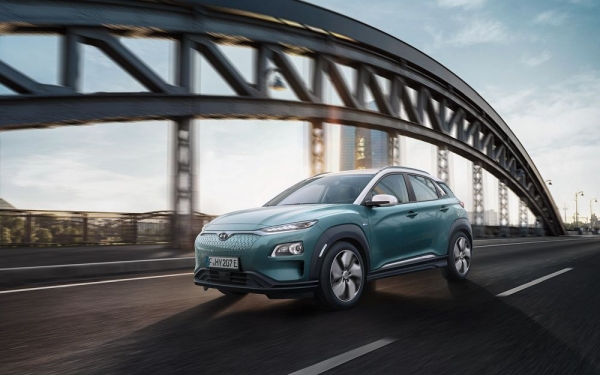
9.7.2019. Hyundai has two more significant prizes for the future-oriented get the orientation of its drive technologies.
Hyundai has two more significant prizes for the future-oriented get the orientation of its drive technologies. In the case of the Automotive innovation Awards of the Center of Automotive Management (CAM) and PricewaterhouseCoopers (PwC) which Hyundai awarded last night for the first time as “the most innovative high-volume brand” and “most innovative volume brand – Alternative drives”.
In the framework of a festive gala event in the Sky Lobby in the 48. Floor of the headquarters of PwC Germany’s leading auditing firm, moderated by the journalist and TV presenter Barbara Hahlweg, accepted Jürgen Keller, managing Director of Hyundai Motor Deutschland, the prices.
“Hyundai has already committed to a long time ago of sustainability. So deeds, which are numerous innovations that emerged followed the words. Hyundai is currently the only manufacturer worldwide that offers all of the major alternative forms of propulsion in the series: electric, Hybrid, 48-Volt mild-hybrid, Plug-in Hybrid and fuel-cell drive.“
Jürgen Keller
Managing Director of Hyundai Motor Germany
Kona electric is the largest electric car in the Segment of small SUV
The innovations in the field of alternative drives, gave Hyundai’s success in the category of “most innovative volume brand,” a Hyundai with a total of 43 index points, ahead of Ford and VW graduated. “Responsible for, among other things, with almost 18 per cent, a particularly high proportion of innovations attributed to the alternative drive systems is,” reads the statement of the Jury. For this purpose, the Hyundai Kona electric, for example, counts as the largest battery electric vehicle in the Segment of small SUV.
The Kona electric achieved with only a cargo of remarkable 449 kilometres to the WLTP cycle. Even 613 miles, the professionals of the trade journal Auto Bild went with only one battery charge for a test drive on public roads with speeds up to 100 km/h. their conclusion in the summer of 2018: “The eternal is the range of debate is off the table.”
Hyundai Nexo convinced thanks to higher efficiency
To is one of the main innovators at Hyundai, the Jury combined the Nexo (consumption of hydrogen in kg H2/100 km: urban from 0.77, extra-urban of 0.89,: 0,84. CO2-emission in g/km combined: 0): “in addition to its fuel-cell drive he has, for example, Blind Spot View Monitor (blind spot camera), the Highway Driving Assist (part of Autonomous Driving), and the Remote-Parking function, which in this Segment for the first time, a vehicle car Parking can.”
Kona electric and Nexo also play at the award ceremony of the prize “the most innovative high-volume brand – Alternative drives” a decisive role. With the new Nexo Hyundai, after the ix35 Fuel Cell, the since 2013 the world’s first series-produced fuel cell vehicle, the second Generation of an electric model, which uses as an energy carrier hydrogen in the offer. This convinced the Jury. An important role is also played by the high range of 666 miles, that is achieved with a tank filling of hydrogen plays (after WLTP-Norm), which makes the Nexo is the ideal alternative powertrain for the long haul.
In addition, the innovative study on “Kite” to the success of Hyundai contributes. In the electric Buggy four electric motors as wheel hub motors in the wheels for propulsion.
CAM database, as a Basis for innovation study
As the basis for the Awards, a study among car manufacturers and suppliers, as well as the CAM, the database of the independent Institute for empirical automotive and mobility research, Center of Automotive Management in Bergisch-Gladbach, Germany, headed by the well-known car expert, Prof. Dr. Stefan Bratzel is used. Based on these data the most outstanding innovations of the year will be determined within the automotive industry.
“The automobile is a technical product, therefore, technical innovations are important elements of the brand identity and the competitiveness of car manufacturers. Successful innovation can account for the success of a model, of a series or of a whole automobile manufacturer.“
Felix Kuhnert
Global Automotive Leader at PwC
Fuel consumption and emission figures
Fuel consumption (hydrogen) in kg H2/100 km for the Hyundai Nexo: urban 0,77, extra-urban 0,89, combined: 0,84. CO2-emission in g/km combined: 0. CO2-efficiency class: A+.
Fuel consumption in kWh/100 km combined for the Hyundai Kona electric: 15,4-15,0; CO2 emissions in g/km combined: 0; CO2 efficiency class: A+.
The stated fuel consumption and CO2 emission values were determined in accordance with the prescribed WLTP-method of measurement and in the NEDC-values converted.


Hyundai Kona Electric (Photo: Hyundai)